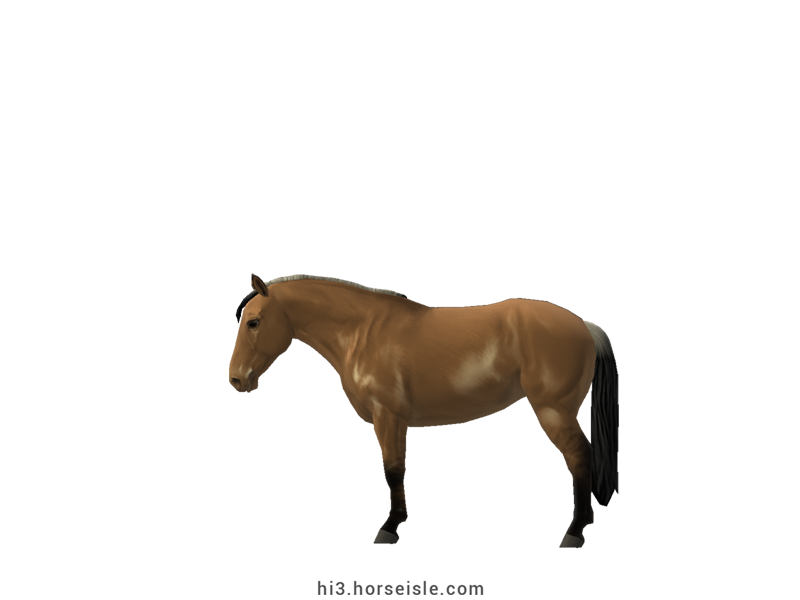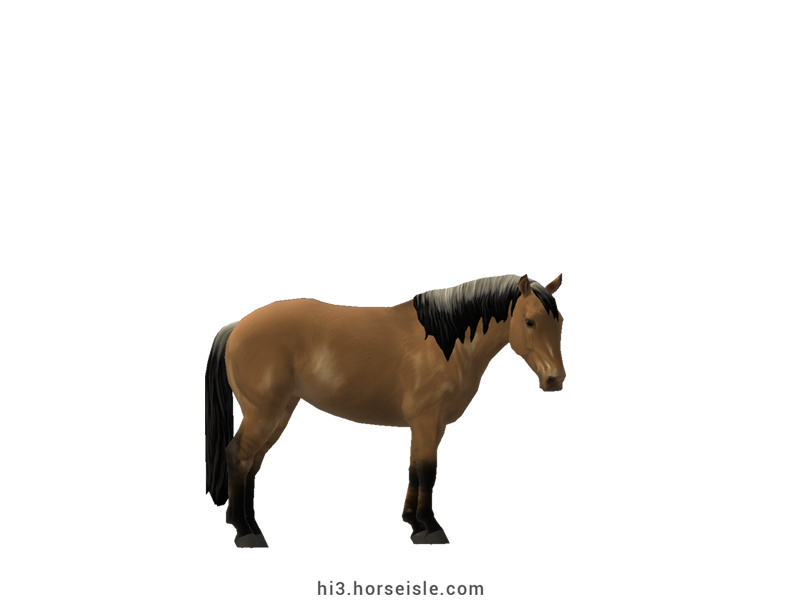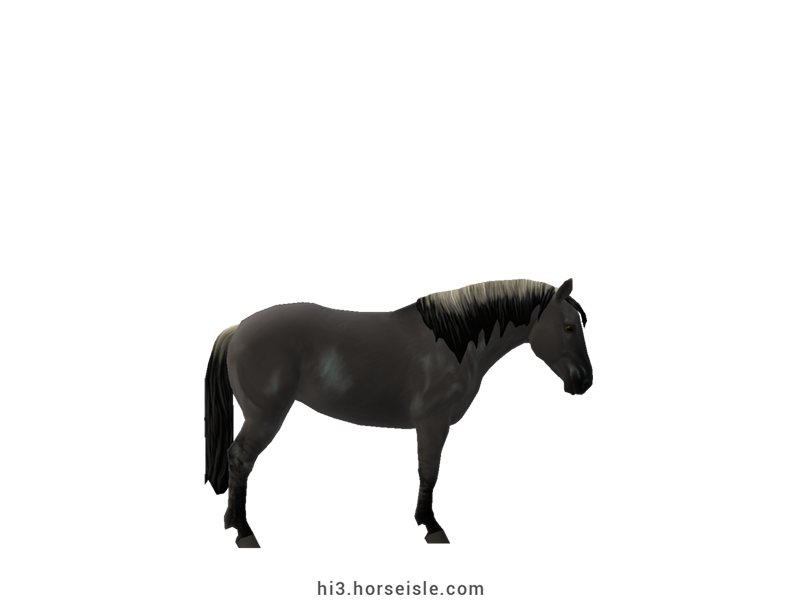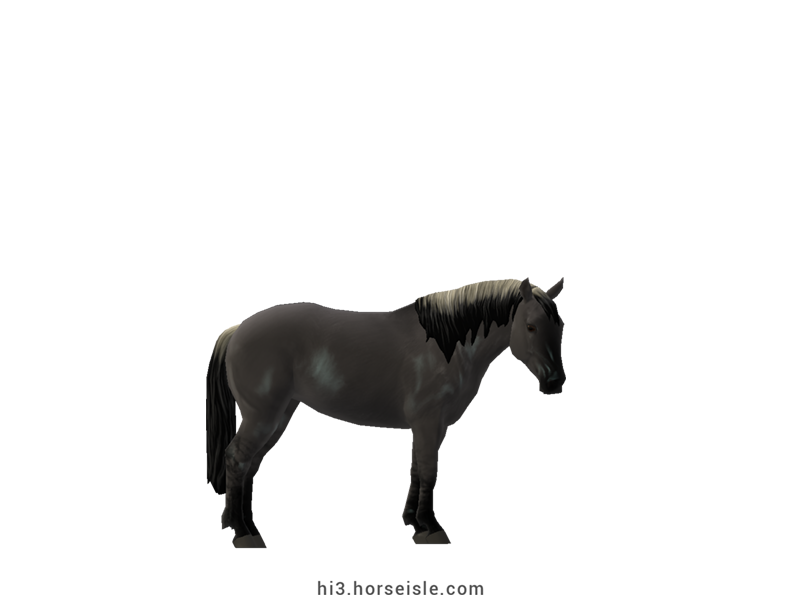Our Massive Real World Equine Reference!
[ INDEX ] Equine Type: Horse Breed: Dulmen Pony (Dulmen) [ PREV ] [ NEXT ]
The Dulmen Pony (also known as 'Dulmener', and formerly as 'Merfeld Horse') is a semi-feral pony breed that roams the Merfelder Bruch Nature Reserve in Dulmen, Westphalia, Germany. It is sometimes regarded as the last authentic wild breed in Europe, but this is incorrect, since the true Dulmen horse went extinct in the 20th century.
The wild horses of Merfeld:
Wild horses have roamed the region of Dulmen for centuries, with the earliest documentation of them dating back to 1,316. The herd did well until the 19th century, when many of its members were captured, similarly to members of other wild herds in Europe (e.g. the Tarpan;. see 'Konik' for more info).
Luckily for the 'Merfeld Horse', as it was known at the time, Alfred von Croy, the 10th Duke of Croy, ordered the capture and transfer of 20 ponies to Merfelder Bruch, where he established a reserve to protect the ponies from harm.
By the end of the 19th century, this little herd of Dulmen ponies was the last herd of wild horses remaining in Germany.
The extinction of the original Dulmen:
Although the small herd of ponies was protected in the reserve, it still faced one risk: excessive inbreeding. During the early 20th century, the blood of foreign breeds was introduced in small quantities into the Dulmen herd as a way to address the inbreeding concern. However, the herd remained small.
During the 1950s, a decision was made to introduce new blood into the herd while re-establishing its primitive appearance. Which appearance was it? At the time, it was believed that the appearance of the 'original' Dulmen ponies was identical to that of the Tarpan.
The Tarpan was a blue-dun wild horse who roamed Eastern Europe until the 19th century when it went extinct. During the 20th century, it was widely believed that the Tarpan was the ancestor of all wild horses in Europe, and, accordingly, that the original Dulmen Ponies had a similar appearance and conformation to that of the Tarpan. This was in direct contrast with the color of the ponies on the Dulmen herd, since they were bay.
Because the Tarpan was extinct, conservationists at the time turned to the breed that resembled it the most: a semi-feral Polish breed called 'Konik', which in itself was the result of crossing Tarpans with domesticated horses during the 19th century, and was later bred to resemble the Tarpan(see the 'Konik' for more info).
During the following years, more and more Polish Konik blood was introduced into the Dulmen breed, resulting in the complete deletion of any unique physical aspects in the Dulmen. The most striking difference was in the coat, as bay was erased almost completely from the breed and replaced with either dun or grulla.
Ironically, it was this excessive crossbreeding that eventually led to the extinction of Germany's last herd of wild horses, although the mistake was discovered only decades later, during the 2000s, by genetic studies. It turned out that the original appearance of the Dulmen Ponies, who had bay coats, was closer to that of their ancestors which were probably bay as well, and did not resemble the Tarpan.
The Dulmen Pony today:
Despite the mistake, Dulmen Ponies are still considered an integral part of Dulmen's legacy and tradition. A herd of Dulmen mares and their foals roams freely in the Merfeld Bruch Nature Reserve together with a single stallion. The herd fends for itself with no assistance at all, except for receiving hay if the pastureland is not enough for the horses in winter. This ensures the adaptability of the ponies to their environment.
Once a year, on the last Saturday of May, the herd is rounded up in a large event that takes place in Dulmen. Male yearlings are removed from the herd, and the stallion might be replaced with a new one. Afterwards, the herd is herded back to the reserve.
Dulmen Ponies who are removed from the herd are later sold. After training, they often serve for recreational riding.
Conformation:
As mentioned above, the Dulmen Pony of nowadays was highly influenced by the Polish Konik. This influence is apparent in the Dulmen's conformation which resembles that of the Konik.
Dulmen Ponies have a concave-to-straight profile, small ears, a short neck, low withers, a short back, a sloping croup, hooves that can be small, and an overall compact build.
The tail usually grows long and thick, but the mane is shorter and thinner, or medium length. The kegs are either clear from feathering or have light feathering on the pasterns.
Performance metrics:
The following are the: range, average, (SD), and MOE of performance metrics of ordered Dulmen Ponies in Horse Isle (not bred ones). In rare cases,horses might have metrics outside of the range. Breeders can produce horses that are beyond this range.
Speed: 13.2-14.3, 13.7 (0.2), 0.04.
Sprint: 40-51, 44 (2), 0.46.
Accel: 0.91-1.09, 0.99 (0.04), 0.01.
Decel: 0.86-1.03, 0.95 (0.03), 0.01.
Jump: 4.86-5.11, 4.99 (0.05), 0.01.
Pull: 1.82-2.36, 2.05 (0.11), 0.02.
Turning: 44.52-59.22, 51.84 (3.07), 0.6.
Reverse: 2.3-2.9, 2.6 (0.1), 0.03.
Stamina: 47.00-51.40, 49.20 (0.95), 0.19.
Reaction: 0.63-0.74, 0.69 (0.02), 0.00.
Coats & Height:
Colors: usually light grulla or dun, less often black or bay (termed 'brown' in Horse Isle because it results from homozygous extension E).
What about chestnut? While some texts mention chestnut, newer sources don't mention 'chestnut' anymore. We also didn't find records of chestnut Dulmen Ponies from recent years. Therefore, in Horse Isle, chestnut does not exist in Dulmen Ponies.
Additionals: Always have zebra stripes on the legs and a dorsal line along the back. White markings are not found in this breed except for the occasional white star.
Height: usually 12.3hh to 13.1hh, but the full height range is 12.1hh to 13.1hh.
The wild horses of Merfeld:
Wild horses have roamed the region of Dulmen for centuries, with the earliest documentation of them dating back to 1,316. The herd did well until the 19th century, when many of its members were captured, similarly to members of other wild herds in Europe (e.g. the Tarpan;. see 'Konik' for more info).
Luckily for the 'Merfeld Horse', as it was known at the time, Alfred von Croy, the 10th Duke of Croy, ordered the capture and transfer of 20 ponies to Merfelder Bruch, where he established a reserve to protect the ponies from harm.
By the end of the 19th century, this little herd of Dulmen ponies was the last herd of wild horses remaining in Germany.
The extinction of the original Dulmen:
Although the small herd of ponies was protected in the reserve, it still faced one risk: excessive inbreeding. During the early 20th century, the blood of foreign breeds was introduced in small quantities into the Dulmen herd as a way to address the inbreeding concern. However, the herd remained small.
During the 1950s, a decision was made to introduce new blood into the herd while re-establishing its primitive appearance. Which appearance was it? At the time, it was believed that the appearance of the 'original' Dulmen ponies was identical to that of the Tarpan.
The Tarpan was a blue-dun wild horse who roamed Eastern Europe until the 19th century when it went extinct. During the 20th century, it was widely believed that the Tarpan was the ancestor of all wild horses in Europe, and, accordingly, that the original Dulmen Ponies had a similar appearance and conformation to that of the Tarpan. This was in direct contrast with the color of the ponies on the Dulmen herd, since they were bay.
Because the Tarpan was extinct, conservationists at the time turned to the breed that resembled it the most: a semi-feral Polish breed called 'Konik', which in itself was the result of crossing Tarpans with domesticated horses during the 19th century, and was later bred to resemble the Tarpan(see the 'Konik' for more info).
During the following years, more and more Polish Konik blood was introduced into the Dulmen breed, resulting in the complete deletion of any unique physical aspects in the Dulmen. The most striking difference was in the coat, as bay was erased almost completely from the breed and replaced with either dun or grulla.
Ironically, it was this excessive crossbreeding that eventually led to the extinction of Germany's last herd of wild horses, although the mistake was discovered only decades later, during the 2000s, by genetic studies. It turned out that the original appearance of the Dulmen Ponies, who had bay coats, was closer to that of their ancestors which were probably bay as well, and did not resemble the Tarpan.
The Dulmen Pony today:
Despite the mistake, Dulmen Ponies are still considered an integral part of Dulmen's legacy and tradition. A herd of Dulmen mares and their foals roams freely in the Merfeld Bruch Nature Reserve together with a single stallion. The herd fends for itself with no assistance at all, except for receiving hay if the pastureland is not enough for the horses in winter. This ensures the adaptability of the ponies to their environment.
Once a year, on the last Saturday of May, the herd is rounded up in a large event that takes place in Dulmen. Male yearlings are removed from the herd, and the stallion might be replaced with a new one. Afterwards, the herd is herded back to the reserve.
Dulmen Ponies who are removed from the herd are later sold. After training, they often serve for recreational riding.
Conformation:
As mentioned above, the Dulmen Pony of nowadays was highly influenced by the Polish Konik. This influence is apparent in the Dulmen's conformation which resembles that of the Konik.
Dulmen Ponies have a concave-to-straight profile, small ears, a short neck, low withers, a short back, a sloping croup, hooves that can be small, and an overall compact build.
The tail usually grows long and thick, but the mane is shorter and thinner, or medium length. The kegs are either clear from feathering or have light feathering on the pasterns.
Performance metrics:
The following are the: range, average, (SD), and MOE of performance metrics of ordered Dulmen Ponies in Horse Isle (not bred ones). In rare cases,
Speed: 13.2-14.3, 13.7 (0.2), 0.04.
Sprint: 40-51, 44 (2), 0.46.
Accel: 0.91-1.09, 0.99 (0.04), 0.01.
Decel: 0.86-1.03, 0.95 (0.03), 0.01.
Jump: 4.86-5.11, 4.99 (0.05), 0.01.
Pull: 1.82-2.36, 2.05 (0.11), 0.02.
Turning: 44.52-59.22, 51.84 (3.07), 0.6.
Reverse: 2.3-2.9, 2.6 (0.1), 0.03.
Stamina: 47.00-51.40, 49.20 (0.95), 0.19.
Reaction: 0.63-0.74, 0.69 (0.02), 0.00.
Coats & Height:
Colors: usually light grulla or dun, less often black or bay (termed 'brown' in Horse Isle because it results from homozygous extension E).
What about chestnut? While some texts mention chestnut, newer sources don't mention 'chestnut' anymore. We also didn't find records of chestnut Dulmen Ponies from recent years. Therefore, in Horse Isle, chestnut does not exist in Dulmen Ponies.
Additionals: Always have zebra stripes on the legs and a dorsal line along the back. White markings are not found in this breed except for the occasional white star.
Height: usually 12.3hh to 13.1hh, but the full height range is 12.1hh to 13.1hh.
[ INDEX ] [ PREV ] [ NEXT ]








